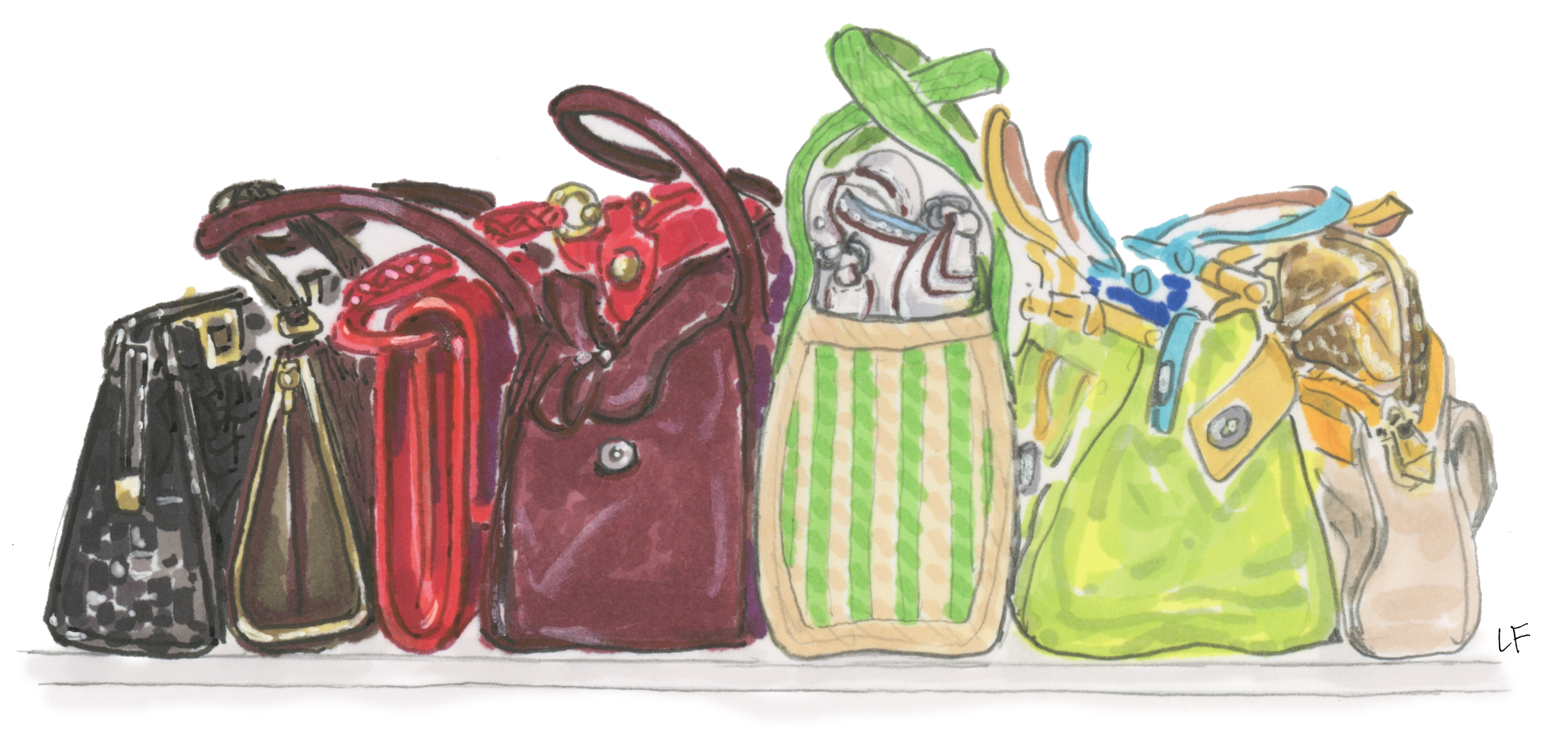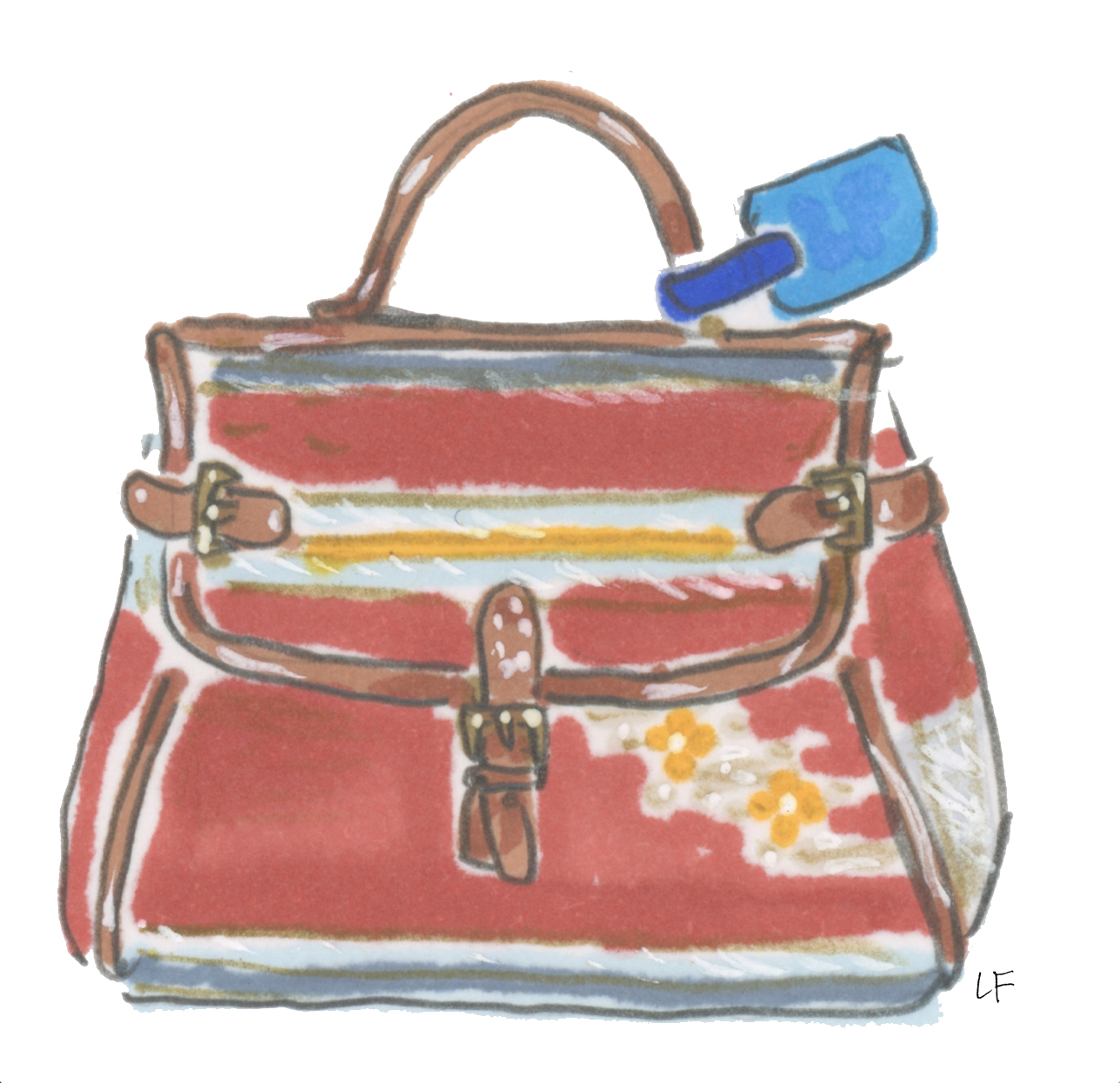The Feminist History of the Handbag
Perhaps it’s because they’re not “necessary”, per se, like a pair of pants or a jacket. Perhaps it’s because we’ve been wearing them about as long as we humans have walked this earth. Or perhaps it’s because they are, indeed, magical — regardless, accessories are more than just adornment. They can be talismanic, amuletic, or simply something we never leave the house without, but beneath the surface, our accessories tell an enduring story about human history and connection better than any other item we put on our bodies. I write about this in my newest book, 50 Ways to Wear Accessories, but space limitations prevented me from diving too far into one particular accessory I think tells a most remarkable story of womanhood in the Western world, an accessory whose practicality belies the deeply held cultural symbol of femininity it’s evolved into. The handbag is a vehicle of understanding a history of womankind.
Before there were totes, clutches, or pocketbooks, humans carry pouches, usually made of animal skin. By the time we arrive at the Greek and Roman periods, the size of a person’s pouch signifies the carrier’s place in society. The smaller the pouch, for women and men, the higher the status — carrying nary but a few items in a tiny purse signals that there’s someone working below in rank that does all the heavy lifting (Consider this the next time you see a picture of a celebrity carrying not much else besides their cellphone!).
In addition to social status, the purse is employed as a symbol for the womb. The Roman goddess of fertility, Uberitas, is depicted carrying a purse full of seeds. A purse, filled with seeds and coins, is gifted during Roman wedding rituals, suggesting the fertility of a bride, her value, tied up in those purse strings, with her ability to reproduce.
This early purse, tied to a belt or girdle and dangling next to the body, proved to be dangerous for exposing one’s possessions to the threat of thieves. In response, the pouch develops into what we know of today as a pocket, retreating into the safety of closeness to the body in a person’s clothing. By the seventeenth century, while large pockets are sewn into men’s clothes, women’s pockets are smaller, tied around the waist, and concealed under her skirts. Her most closely held possessions are accessed by reaching through yards of fabric, entry gained only by finding the opening in the skirt to locate the opening in the separate pocket. And while it’s form has slightly changed, the association of a purse to a woman’s fertility, sexuality, and gender persists, perhaps even strengthened by it’s body-adjacent location. This indelible connection turns sinister when we hear from pick-pocketer’s of the time, who describe their forays into reaching up a woman’s skirts and taking off with her purse pockets in ways that dovetail neatly with today’s language of rape culture.
By the eighteenth century, women’s fashion evolves in accordance with the European revival of Greek and Roman classicism. Mirroring the draped styles of the past, women of the middle class swath themselves in diaphanous muslin shifts which leave little to the imagination: closely following the curves, revealing the breasts, and perhaps most scandalously for the time, exposing the outline of the contents of a woman’s pockets. Here is an early example of today’s “VPL”, or visible panty line: the visible pocket line. Sordid was the vision of seeing the contents of a woman’s pockets traced with the eyes without actually knowing the what was truly inside.
In accordance with the discord between bulky pockets and curve-hugging dresses, the next generation of purse, the reticule, emerges. Essentially just a pocket with a string attached, it continues to carry connotations of a woman’s sexuality. Made from satin, heavily embellished and embroidered, reticules are, almost unfathomably to us today, one of the first appearances of the “underwear as outwear” trend. At the time that women begin carrying reticules, it is thought to be as scandalous as a woman lifting up her skirts to show her undergarments in public.
For an accessory to be seen as so appalling, it begs the question, how does this item act as a prism of understanding for how the carrier is viewed at this time? How does society value a woman when the simple act of her toting her belongings in a cute accessory is seen as disturbing? When a woman tucks into her satiny purse, her reticule contains an answer, a vision of how she fits into her community: she, and the contents of her purse, are to be suggested at but not truly shown, for what is inside is too scandalizing to be out in the open. She, and her purse, could be seen but not understood. Should be out for display while still hiding everything.
So what’s inside these shocking reticules? We might recognize some of the elements from the contents of today’s purses: rouge, powder, calling cards, perhaps a fan. Glaringly absent, however, is anything representing money. Women of this age had little, if any, financial autonomy. (Remember - it wasn’t until 1974 that a woman could apply to open a credit card in her name in the United States.) At the same time, accessories, and fashion in general, are tellingly binding, severely restricting the wearer’s movements and facilities. Complicated hairstyles, constricting bonnets, bone-stay corsets, neck ruffs, teetering shoes practically impossible to walk in, even the reticule, dangling from the wrist and rendering one’s arm useless, has me reconsidering how much constriction I should willing to put up with by carrying a bag in one hand in this day and age! A woman’s role in society, and how she deigned to get dressed, was a deliberate foil to a masculine archetype. The Industrial Revolution ushered in increasingly stratified, static spheres between men and women, and in doing so, governed the styles that reinforced these gender norms. The idealized man was industrious, strong, and active, his image bolstered by a female supporting cast who stayed at home, protected, pretty to look at, immobile, and silent, with no effort given to understanding her.
The Industrial Revolution ushers in different kinds of change, though. The proliferation of train travel paves the way for a new dawn of voyaging for people with disposal income. The accessory taken on this journey is the carpet bag. An ideal companion for long treks, a person could carry their belongings in it, and then use it as a blanket on overnight trips. (Although originally carried by men, the carpet bag was adopted, and perfected by a woman: Mary Poppins, whose carpet bag and umbrella are now iconic accessory looks.) With the discovery of new places and ideas comes the rumble of societal and social developments.
The handbag as we know it today does not appear until the early 20th century. Made from leather and structured around a bag frame with a handle, it’s arrival tellingly lines up with the time that women actively fight for rights, including the right to vote and access to financial autonomy. No longer relegated to accessing belongings through skirt folds or carrying a literal pocket with strings attached, it’s no mistake that women enjoy the protection of carrying a bag that snaps safely shut concurrently to when they begin carrying money and accessing their own purchasing power.
Nonetheless, not all women were happy with these new handbags. Suffragettes and some of the early American feminists used the comparison between a handbag, which was notably diminutively sized, and men’s generously-sized pockets to illustrate the disparity between men’s and women’s rights. In Herland, a utopian novel written by Charlotte Perkins Gilman in 1915, she imagines a world where Amazonian goddesses rule, roaming the earth wearing outfits covered in pockets. This disparity between men and women’s pocket sizes still persists today.
Throughout the rest of the 20th century, the handbag continues to be representative of a woman’s value and her personal liberties within society. In the 1950’s, the symbolic marker for a girl metamorphosing into a woman is when she acquires her first “good” handbag. By the “swinging” 1960’s, the shoulder bag becomes popular. Freeing up the hands, the shoulder bag allows women a new freedom: freedom of movement, the power of having both hands free. This subtle yet profound change goes hand-in-hand with the revolutionary sexual rights women advocated for in the 1960’s.
When I first learned about this history, I must admit, it made the weight I bear in my purse feel much, much heavier. Most of the time, we don’t have a choice about what we have to carry, but acknowledging the long road to how our loads came to be held in this ubiquitous accessory can be empowering, I think. My bag, my choice. It’s also why I’m here today to say that the most radical accessory among all our carrier-of-things choices is the fanny pack. Not only does it afford the wearer a hands-free lifestyle, but it is also gender neutral. An equal burden of the weight — what could be more revolutionary than that?
*For more information on the history of the handbag, I recommend checking out “The Handbag: An Illustrated History”, by Caroline Cox.
To see this original post on the Chronicle Books Blog, click here.








